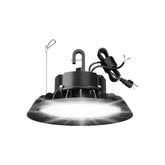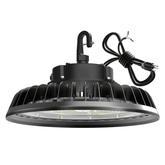High Bay vs Low Bay Lighting
The main difference between low-profile lighting and overhead lighting lies in their installation positions and respective lighting methods.
1. Installation height
High bay overhead lighting is suitable for high ceilings. Consider those lighting fixtures that will be suspended in the air, in elevated areas, typically referring to places with a height exceeding 20 feet (up to 6 meters) or higher, such as positions 25 or 30 feet (up to) from the ground. Some specifications even set the starting height even higher, reaching 25 or 30 feet.
Low bay pendant lights are suitable for ceilings with a height of 20 feet (about 6 meters) or lower. They are usually installed on ceilings with a height between 12 and 20 feet (about 3.5 to 6 meters).

2. Light Distribution and Beam Angle
High bay lighting usually requires a more compact and concentrated beam angle. If lighting is from a distant place or from a high altitude, the beam needs to be narrowed so that it can continuously shine downward onto the ground without spreading and wasting energy. Common beam angles range from 60 degrees to 90 degrees. If the installation location is very high, the angle can be even smaller.
For low bay lighting near the target space, a beam angle of 100 degrees to 120 degrees or even wider can be used. They can illuminate a larger area within a shorter distance, thus achieving uniform lighting throughout the space.

3. Lighting Design and Heat Dissipation:
The design of lighting fixtures typically indicates their intended use and the power they can handle. High ceiling lights, especially older types such as metal halide lamps or high-pressure sodium lamps, generate a significant amount of heat. This is why their shapes often feature large radiators or reflectors, and these designs also help regulate temperature. Modern LED ceiling lights are more energy-efficient and emit less heat, yet they still have a sturdy design and sufficient heat management capabilities to ensure a long lifespan, especially considering the large amount of light they need to emit. Low ceiling lights handle less power and may have simpler or smaller designs.









